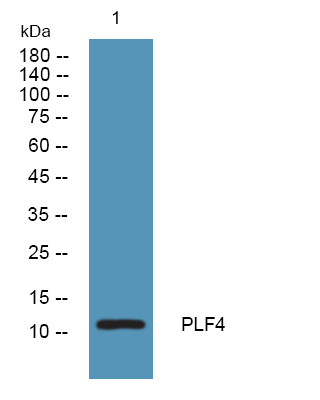PF-4 Polyclonal Antibody
- Catalog No.:YT6006
- Applications:WB;ELISA;IHC
- Reactivity:Human;Rat
- Target:
- PF-4
- Fields:
- >>Cytokine-cytokine receptor interaction;>>Viral protein interaction with cytokine and cytokine receptor;>>Chemokine signaling pathway
- Gene Name:
- PF4 CXCL4 SCYB4
- Protein Name:
- Platelet factor 4 (PF-4) (C-X-C motif chemokine 4) (Iroplact) (Oncostatin-A) [Cleaved into: Platelet factor 4, short form]
- Human Gene Id:
- 5196
- Human Swiss Prot No:
- P02776
- Mouse Gene Id:
- 56744
- Mouse Swiss Prot No:
- Q9Z126
- Rat Swiss Prot No:
- P06765
- Immunogen:
- Synthetic peptide from human protein at AA range: 51-100
- Specificity:
- The antibody detects endogenous PF-4
- Formulation:
- Liquid in PBS containing 50% glycerol, 0.5% BSA and 0.02% sodium azide.
- Source:
- Polyclonal, Rabbit,IgG
- Dilution:
- WB 1:500-2000;IHC 1:50-300; ELISA 2000-20000
- Purification:
- The antibody was affinity-purified from rabbit antiserum by affinity-chromatography using epitope-specific immunogen.
- Concentration:
- 1 mg/ml
- Storage Stability:
- -15°C to -25°C/1 year(Do not lower than -25°C)
- Other Name:
- Platelet factor 4 (PF-4;C-X-C motif chemokine 4;Iroplact;Oncostatin-A) [Cleaved into: Platelet factor 4, short form]
- Molecular Weight(Da):
- 11kD
- Background:
- This gene encodes a member of the CXC chemokine family. This chemokine is released from the alpha granules of activated platelets in the form of a homotetramer which has high affinity for heparin and is involved in platelet aggregation. This protein is chemotactic for numerous other cell type and also functions as an inhibitor of hematopoiesis, angiogenesis and T-cell function. The protein also exhibits antimicrobial activity against Plasmodium falciparum. [provided by RefSeq, Oct 2014],
- Function:
- function:Released during platelet aggregation. Neutralizes the anticoagulant effect of heparin because it binds more strongly to heparin than to the chondroitin-4-sulfate chains of the carrier molecule. Chemotactic for neutrophils and monocytes. Inhibits endothelial cell proliferation, the short form is a more potent inhibitor than the longer form.,mass spectrometry: PubMed:7644496,mass spectrometry:Short form PubMed:7644496,online information:CXCL4 entry,PTM:Binds non-covalently to a proteoglycan molecule.,similarity:Belongs to the intercrine alpha (chemokine CxC) family.,subunit:Homotetramer.,
- Subcellular Location:
- Secreted .
- Expression:
- Leukocyte,
SANT, a novel Chinese herbal monomer combination, decreasing tumor growth and angiogenesis via modulating autophagy in heparanase overexpressed triple-negative breast cancer. JOURNAL OF ETHNOPHARMACOLOGY J Ethnopharmacol. 2021 Feb;266:113430 WB Human MDA-MB-231 hpa (231-Hpa)cell-Xenograft,MDA-MB-231 mock (231-Mock) cell-Xenograft
- June 19-2018
- WESTERN IMMUNOBLOTTING PROTOCOL
- June 19-2018
- IMMUNOHISTOCHEMISTRY-PARAFFIN PROTOCOL
- June 19-2018
- IMMUNOFLUORESCENCE PROTOCOL
- September 08-2020
- FLOW-CYTOMEYRT-PROTOCOL
- May 20-2022
- Cell-Based ELISA│解您多样本WB检测之困扰
- July 13-2018
- CELL-BASED-ELISA-PROTOCOL-FOR-ACETYL-PROTEIN
- July 13-2018
- CELL-BASED-ELISA-PROTOCOL-FOR-PHOSPHO-PROTEIN
- July 13-2018
- Antibody-FAQs
- Products Images

- Western blot analysis of lysates from SW480 cells, primary antibody was diluted at 1:1000, 4°over night


